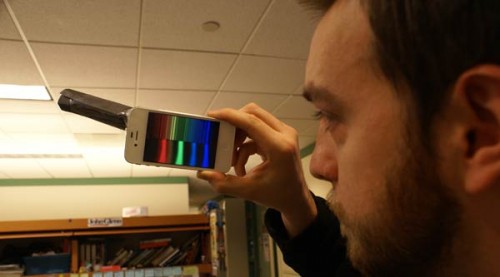
APS Outreach Specialist James Roche shows off SpectraSnapp. (Courtesy: Mike Lucibella/APS)
By Hamish Johnston and Tushna Commissariat
This was Nobel week, and physicists had two prizes to celebrate this year. Of course there was the prize for physics, which this year went to Peter Higgs and François Englert for their theoretical prediction of the Higgs boson in 1964.
Shortly after the physics-prize announcement, Englert was on the phone to Stockholm, but the Nobel officials couldn’t seem to find Higgs. Early rumours were that he had retreated to the Highlands of Scotland to avoid the media glare, but a few hours later he was photographed outside his Edinburgh home by The Scotsman newspaper.
Later, the BBC reported that Higgs was told about his Nobel win by a passer-by on an Edinburgh street, who stopped her car when she spotted the physics laureate on the pavement. “She congratulated me on the news and I said ‘Oh, what news?’,” Higgs is quoted as saying.
While the physics Nobel was covered by many blogs and media outlets, if you want a blow-by-blow account of how Englert, Higgs (and others) came to their prediction nearly 50 years ago, we recommend Matt Strassler’s blog entry “The Twists and Turns of Hi(gg)story“.
There was also the chemistry prize this week, which went to Martin Karplus, Michael Levitt and Arieh Warshel for theoretical work that to us looks more like physics than chemistry. Indeed, a chemist colleague told us that the 2013 prize came as a surprise to many chemists and a few days before it was announced the Caltech chemist Paul Bracher had Karplus as a 99-1 outsider on his ChemBark blog.
While next year is the official International Year of Crystallography, 2013 is also being celebrated as the Bragg Centenary, as it has been 100 years since the pioneering work done by William Henry Bragg and son William Lawrence Bragg as they laid down the foundations of X-ray crystallography. Both the British Crystallographic Association and the Royal Institution have dedicated pages to mark this occasion, and they both have some excellent videos and information on the subject.
We also came across this interesting post on the Physics Central blog about a nifty new iPhone app that lets you turn your phone into a spectrometer. All you need is the app, a diffraction grating and some cardboard and you are good to go. The app – called SpectraSnapp – has been created by the American Physical Society and you can download it at the iTunes store free of charge.
And finally, for a bit of light weekend relief, you can watch this video of Grover from Sesame Street doing five science experiments for kids, thanks to the folks at 5 Facts.
Guidelines
Show/hide formatting guidelines
this text was deletedwhere people live in harmony with nature and animals</q>
Some text